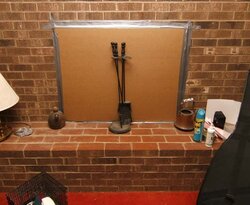Just found the forum. Have looked around a little. I may not use the correct terms in my questions, so please be patient with me.
Here is my quandary: I have had vent free gas logs in my brick fireplace for about 10 years now. Due to the cost of gas, I have decided to get rid of the logs and find another way to use the fireplace as supplemental heat. I am trying to do this as inexpensively as possible. Looks are not terribly critical.
One wall in a downstairs room is totally bricked over. The fireplace is in the center, and 16" above the floor. A 16"X16" (height and depth) brick shelf runs the entire length of the wall. The fireplace at the opening is 35" wide, 27" high, and 22" deep. The chimney is fine. Since the fireplace is on the ground floor, the chimney is high, probably 20-25' above the fireplace since it is at the peak of the roof.
I would like to put a stove in the fireplace (partially in the fireplace). An insert would be ok but I do not want anything that will require a fan to push the heat out into the room. If I use a stove, I would like to have most of it sticking out in front of the fireplace so it can radiate heat (we loose power a lot in the winter).
So, some questions:
1-Any suggestions on stoves?
2-Since space is limited because of the fireplace being 16" off the floor, would I need to get a stove that I can remove the back legs so that the rear sits on the bricks, and leave the legs on the front so that they could extend down to the floor?
3-How do I vent the stove? Do I remove the damper and run the stove vent out through the damper opening? Also, since the chimney is about 10" in diameter, do I need to run the stove vent pipe all the way to the top of the chimney, or just inside the bottom of the chimney?
4-How do you seal up the space around the stove vent where it goes through the damper opening?
5-Would I need a stove that vents out the top or back, or does it matter?
I took a picture for reference. Excuse the cardboard taped over the fireplace. A few flies were in the room and my son was afraid they may have come in through the fireplace.
Any advice would be appreciated.
Here is my quandary: I have had vent free gas logs in my brick fireplace for about 10 years now. Due to the cost of gas, I have decided to get rid of the logs and find another way to use the fireplace as supplemental heat. I am trying to do this as inexpensively as possible. Looks are not terribly critical.
One wall in a downstairs room is totally bricked over. The fireplace is in the center, and 16" above the floor. A 16"X16" (height and depth) brick shelf runs the entire length of the wall. The fireplace at the opening is 35" wide, 27" high, and 22" deep. The chimney is fine. Since the fireplace is on the ground floor, the chimney is high, probably 20-25' above the fireplace since it is at the peak of the roof.
I would like to put a stove in the fireplace (partially in the fireplace). An insert would be ok but I do not want anything that will require a fan to push the heat out into the room. If I use a stove, I would like to have most of it sticking out in front of the fireplace so it can radiate heat (we loose power a lot in the winter).
So, some questions:
1-Any suggestions on stoves?
2-Since space is limited because of the fireplace being 16" off the floor, would I need to get a stove that I can remove the back legs so that the rear sits on the bricks, and leave the legs on the front so that they could extend down to the floor?
3-How do I vent the stove? Do I remove the damper and run the stove vent out through the damper opening? Also, since the chimney is about 10" in diameter, do I need to run the stove vent pipe all the way to the top of the chimney, or just inside the bottom of the chimney?
4-How do you seal up the space around the stove vent where it goes through the damper opening?
5-Would I need a stove that vents out the top or back, or does it matter?
I took a picture for reference. Excuse the cardboard taped over the fireplace. A few flies were in the room and my son was afraid they may have come in through the fireplace.
Any advice would be appreciated.




